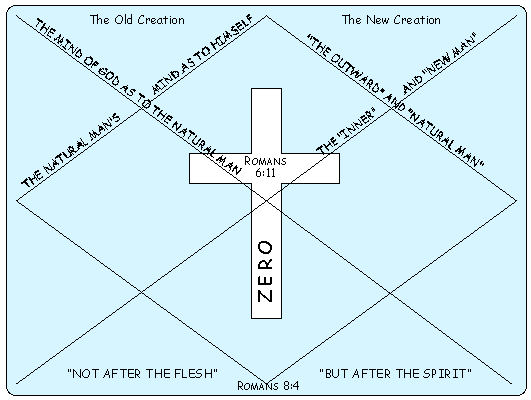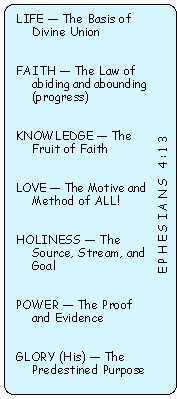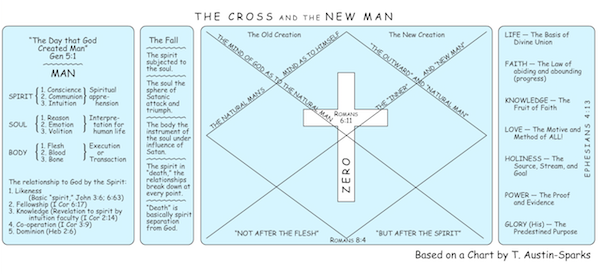
Firstly, we have man “in the day that God created” him (Gen 5:1). His threefold nature is defined.
1. Spirit: with three faculties, Conscience, Communion and Intuition; the main value of which is spiritual apprehension.
2. Soul: with Reason, Emotion, Will or Volition; the function of which is interpretation for human life.
3. Body: of flesh, blood and bone; for executing or transacting the business of spirit and soul.
Then we have the relationship to God by the spirit. This is fivefold:
1. Likeness (basic, “spirit”).
2. Fellowship.
3. Knowledge (spiritual perception).
4. Co-operation.
5. Dominion.

Secondly, we have the “Fall”. The results and effects of this were, and are:
1. The human spirit subjected to the soul.
2. The soul the seat of the Satanic attack and triumph, having come under the power of evil forces.
3. The body, the instrument of the soul, under the influence of Satan, especially for purposes of procreation in man’s own likeness, after his image (Gen 5:3).
Then, by the spirit severed from God in what is meant by spiritual death, the fivefold relationship was disrupted — the likeness marred; the fellowship destroyed; the knowledge obscured; the co-operation made impossible; the dominion forfeited. So man is severed from God, alienated, darkened, spiritually paralysed and “subjected to vanity” (Rom 8:20).
From this point he is called flesh — “in their going astray they are flesh” (Gen 6:3) — and we know from the New Testament that this does not only mean mortality, but the presence of an active principle which is inimical to spirit and to God. Moreover, he is thenceforth known as the “natural man” (soulical). But, above all, he is actuated by “the god of this world” inasmuch as he chose — in his will — to believe in Satan in preference to God.

From this point a double history begins. This is represented in our diagram by the two sets of lines one narrowing, the other broadening. The narrowing lines set forth man’s history from that time according to God’s mind. From being the masterpiece of God’s creative activity, God has “concluded” him under sin because of unbelief (Rom 11:32). So God introduces in type and symbol the principles of the Cross of Christ. Along this line nothing of man himself is ever accepted by God. Certain things — three mainly — are always kept clearly in view:
1. The fact of man’s sinful state, under judgment.
2. Death, being the end of the natural man, to be the due of all, and to be accepted.
3. The perfections of Christ the only basis of all, or any further, relationship with God.
This is what is inherent in the instance of Cain and Abel. This is why death has such a large place in the whole Divine economy. And — wisdom, power and wonder of God! — herein He is seen taking hold of the very tail of the serpent, the very sting of death, the works of the devil, and making death the way of a new life, the pathway to His purpose in the resurrection of Christ and the spiritual resurrection of believers in Him. This, again, is why every offering acceptable to God, to bring man nigh, is to be without blemish. The expert eye of a priest, after the most thorough scrutiny, must be able to say “It is perfect.” (This is actually what Christ cried on the Cross as to the conclusion of all His testings and fiery ordeal — “It is perfect,” not merely concluded or finished.)
On then, ever on, with unvarying, unchanging conclusiveness, God’s mind leads to the Cross of Christ. Whenever a man or a people comes under immediate government of God, in relation to His eternal purpose, they will have one thing brought home to them. It is that in themselves “dwelleth no good thing” (Rom 7:18), that they are accepted only on the ground of a righteousness which is not of themselves, nor of works, but by faith — it is the goodness of Another. This realization will smite the natural man hip and thigh, that out of the smiting there may emerge one such as the Lord can look to, “even to him that is poor and of a contrite spirit” (or “heart”).
So we see that the Cross of Christ is God’s mind as to the natural man, for there the Son of man took not only our sins but ourselves in His representative person, and died under the judgment of God in our stead, or as us (Rom 6:2-10; Col 2:12; II Cor 5:14,15,etc.). This Cross throws its reflex back to the hour of Adam’s sin. It is for want of a complete or adequate realization of the meaning of the Cross, that so many Christians are “carnal,” or try to live for God out of themselves. This goes to the root of the ever-present weakness and poverty of spiritual life. There is much prayer for ‘revival’, and much effort for ‘the deepening of the spiritual life’. The only answer to this is a new knowing of the Cross, not only as to sins and a life of victory over them, but as to Christ as supplanting the natural man.
The conditions at Corinth which caused Paul to write, “I could not speak unto you as unto spiritual, but as unto carnal, as unto babes” (unduly so), were explained in the opening chapters of his first letter as being due to their living so much on the basis of the soulical (“natural”) man; and his only remedy was “Jesus Christ, and him crucified.” Yes, believers, “called saints” (I Cor 1:2) can do this, and can even bring spiritual gifts into the realm where they are soulishly valued and exploited. It is something to make us very sober and steady when we recognize that what is called the “baptism” of the Holy Spirit, with “tongues” and other “gifts” following, does not necessarily carry with it the knowledge of the major things of the spiritual life. Hence Paul had to teach those who had such experiences the real meaning of baptism, the Cross, the Lord’s Table, the Body of Christ, and Sonship. Revelation is something more than gifts or experiences. The manifestation gifts are no marks of spiritual maturity; often the reverse. Herein lies Satan’s most subtle snare. The mistaking of such experiences for deep and real spirituality provides him with his most desired opportunity to lead the most sincere children of God into a false experience. The Cross as deeply applied to the soulical man is the only safeguard against the presentation of what is psychical as a marvellous imitation of what is spiritual.
To continue with our diagram, there is the other aspect. Man has ever refused to recognize and accept God’s verdict about him. Hence he pursues a course of self-expression and self-realization. From his beginning, even when the way of God in Abel’s offering was so definitely enunciated, he pursued his own course. He went out to build a world, to create a civilization, and to constitute a kingdom. Babel or Babylon is its name. It is the expression of and monument to man’s power, ability, and glory. “Let us make us a name” (Gen 11:4). “Is not this great Babylon, which I have built ...?” (Dan 4:30). Thus, he inflates, expands and asserts himself. Yes, it is a wonderful world which he has produced, and it has got quite beyond him. He cannot manage it. Full of wonders, yes — but full of tragedy! It is fast leading to his undoing, and his own productions will wipe out his civilization. He has set something going which, by its own momentum, has got out of his hands. God will have to step in to shorten the days of this issue, or no flesh will be saved (Matt 24:22). That is what is immediately on the horizon. What an amount we could write on this line! but we refrain. Only fools, blind fools, Satan’s dupes, see Utopia as the natural outcome of this present world course. Civilization has only accentuated soul-sense or -sensibility, and we already know something of the meaning of “men’s hearts failing them for fear” (Luke 21:26).
Yet still God’s position is unchanged. Man may build his kingdom, and build it to the clouds, but heaven is closed to him. The Cross of Christ proclaims that God settled the end of all that long since. So that ‘Calvary’ is zero! So far as God’s eternal purpose is concerned, there is no way past the Cross but by death, in identification with Christ by faith. When that place has been taken and all its implications accepted, then a New Man is brought in as by resurrection-union with Christ. “If any man is in Christ, there is a new creation:...” (II Cor 5:17).

From that point another double process begins. There has to be a definite crisis in which all the meaning of God is accepted, whether wholly understood or not. The crisis involves and potentially carries with it everything.
The twofold process is, on the one hand, the ascendency of the new man, the spiritual man; and on the other hand, the subjecting of the natural or old man. This is a life education. It is necessary to understanding. Were God to actually blot out, ’eradicate’, the old man, then the whole basis of spiritual training would be removed. We have elsewhere pointed out what this “newness of life” means in learning everything anew, in a different world, with new spiritual faculties. This new man is the “hidden man of the heart” (I Peter 3:4) and the training of him by “the Father of our spirits” (Heb 12:9) will be in keeping with the earlier statement in the same letter, “the dividing of soul and spirit” (Heb 4:12). If the remainder of the diagram is studied, the meaning of this will be clear; for here is a new and altogether other law “the law of the Spirit of life.” This life has its own law or laws, which have to be known.
It is a faith life. “That life which I now live...I live in faith...” (Gal 2:20). So, knowledge is the fruit of faith. We need go no further, but return to a final emphasis upon the crisis of the Cross. God has nothing to say to man, but there only. Every new development in the life of a child of God will in some way be by a new expression of the meaning of the Cross; deeper death unto fuller life. God keeps the balances with a steady hand, and eventually the last phase of our self-emptying here will issue in enthronement with Christ there.
[ Once again, here is the whole chart. Click to open a larger version in a separate window. ]
